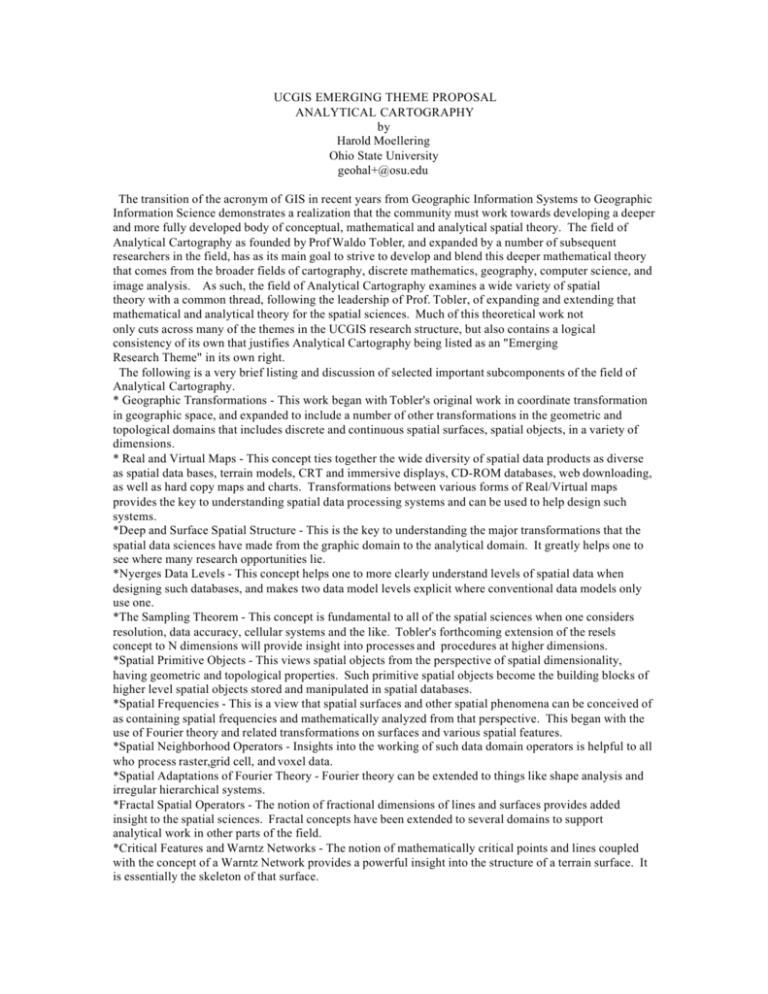
UCGIS EMERGING THEME PROPOSAL
ANALYTICAL CARTOGRAPHY
by
Harold Moellering
Ohio State University
geohal+@osu.edu
The transition of the acronym of GIS in recent years from Geographic Information Systems to Geographic
Information Science demonstrates a realization that the community must work towards developing a deeper
and more fully developed body of conceptual, mathematical and analytical spatial theory. The field of
Analytical Cartography as founded by Prof Waldo Tobler, and expanded by a number of subsequent
researchers in the field, has as its main goal to strive to develop and blend this deeper mathematical theory
that comes from the broader fields of cartography, discrete mathematics, geography, computer science, and
image analysis. As such, the field of Analytical Cartography examines a wide variety of spatial
theory with a common thread, following the leadership of Prof. Tobler, of expanding and extending that
mathematical and analytical theory for the spatial sciences. Much of this theoretical work not
only cuts across many of the themes in the UCGIS research structure, but also contains a logical
consistency of its own that justifies Analytical Cartography being listed as an "Emerging
Research Theme" in its own right.
The following is a very brief listing and discussion of selected important subcomponents of the field of
Analytical Cartography.
* Geographic Transformations - This work began with Tobler's original work in coordinate transformation
in geographic space, and expanded to include a number of other transformations in the geometric and
topological domains that includes discrete and continuous spatial surfaces, spatial objects, in a variety of
dimensions.
* Real and Virtual Maps - This concept ties together the wide diversity of spatial data products as diverse
as spatial data bases, terrain models, CRT and immersive displays, CD-ROM databases, web downloading,
as well as hard copy maps and charts. Transformations between various forms of Real/Virtual maps
provides the key to understanding spatial data processing systems and can be used to help design such
systems.
*Deep and Surface Spatial Structure - This is the key to understanding the major transformations that the
spatial data sciences have made from the graphic domain to the analytical domain. It greatly helps one to
see where many research opportunities lie.
*Nyerges Data Levels - This concept helps one to more clearly understand levels of spatial data when
designing such databases, and makes two data model levels explicit where conventional data models only
use one.
*The Sampling Theorem - This concept is fundamental to all of the spatial sciences when one considers
resolution, data accuracy, cellular systems and the like. Tobler's forthcoming extension of the resels
concept to N dimensions will provide insight into processes and procedures at higher dimensions.
*Spatial Primitive Objects - This views spatial objects from the perspective of spatial dimensionality,
having geometric and topological properties. Such primitive spatial objects become the building blocks of
higher level spatial objects stored and manipulated in spatial databases.
*Spatial Frequencies - This is a view that spatial surfaces and other spatial phenomena can be conceived of
as containing spatial frequencies and mathematically analyzed from that perspective. This began with the
use of Fourier theory and related transformations on surfaces and various spatial features.
*Spatial Neighborhood Operators - Insights into the working of such data domain operators is helpful to all
who process raster,grid cell, and voxel data.
*Spatial Adaptations of Fourier Theory - Fourier theory can be extended to things like shape analysis and
irregular hierarchical systems.
*Fractal Spatial Operators - The notion of fractional dimensions of lines and surfaces provides added
insight to the spatial sciences. Fractal concepts have been extended to several domains to support
analytical work in other parts of the field.
*Critical Features and Warntz Networks - The notion of mathematically critical points and lines coupled
with the concept of a Warntz Network provides a powerful insight into the structure of a terrain surface. It
is essentially the skeleton of that surface.
*Polygon Analysis - Innovations in polygon analysis is a significant part of the field with Thiessen
polygons, Delaunay triangles and their uses. Developments by Tobler on pycnophylactic transformations
from discrete zonal structures to other zonal or continuous structures is a very interesting development in
the field.
*Analytical Map Generalization - Various analytical approaches in the field can supplement conventional
digital approaches in the area.
*Spatial Data Models and Structures - The development and analysis of TIN models as well as global
tessellation models fall into this theme of research.
*Analytical Visualization - This area utilizes analytical approaches to extend and develop better
visualization processes for static, interactive and dynamic spatial displays.
This is only a brief sampling of the many research topics in analytical cartography. Together they add a
perspective to spatial analysis that would be very helpful to researchers in the Geographic Information
Science. This has multiple applications in the field.
-***(C) Copyright 2000, Harold Moellering, All N. American Rights Reserved***
Harold Moellering, Department of Geography, Ohio State University 43210 USA
>>>>>>>>>> E-mail:geohal+@osu.edu -- FAX:+1(614) 292-6213 <<<<<<<<<
**Numerical Cartography Lab Home Page at: http://ncl.sbs.ohio-state.edu/
**ICA Standards Commission Home Page at: http://ncl.sbs.ohio-state.edu/ica
*************** Virtual Maps ===> Virtual Reality ***************








